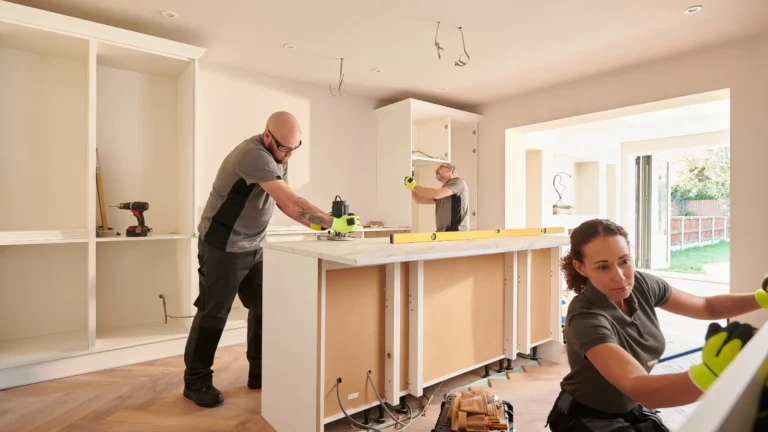A kitchen is the heart of any home, and getting it right means more than just picking nice cabinets and appliances. The real magic happens during the kitchen fitters and installation process, where professional kitchen installers turn your vision into a functional, beautiful space. Whether you’re doing a full kitchen renovation or a simple kitchen makeover, understanding the kitchen fitting process and choosing certified kitchen fitters can make all the difference. This guide will walk you through everything you need to know about kitchen fitting services, from selecting the right professionals to design tips and cost considerations.
Kitchen Fitters and Installation Process
A full kitchen installation involves several key stages, each requiring precision and expertise:
- Initial Consultation and Design: The process starts with kitchen design and installation planning. This includes discussing your needs, style preferences, and budget with your kitchen fitters. They may provide 3D designs or layouts to help you visualise the final result.
- Measurement and Survey: Accurate measurements of your kitchen space are essential. Certified kitchen fitters will conduct a full survey to ensure everything will fit.
- Dismantling and Preparation: If you’re renovating the old kitchen is removed. The area is then prepared which may involve plumbing, electrical work or wall repairs.
- Delivery and Inspection of Materials: Cabinets, appliances and fixtures are delivered and inspected for quality and completeness.
- Installation: Professional kitchen installers will assemble and fit cabinets, worktops, sinks, appliances, and other elements. This stage requires skill to ensure everything is level, secure, and aligned.
- Finishing Touches: This includes fitting handles, backsplashes, lighting,g and any decorative features.
- Final Inspection and Handover: The kitchen fitter will walk you through the installation, address any concerns, and ensure you’re happy with the work.
Each stage is crucial to a high-quality kitchen that will last.
Tips for Choosing the Right Kitchen Fitters
Choosing the right professionals is key to a successful kitchen project. Here are some practical tips:
- Check Credentials: Look for certified kitchen fitters who are licensed and insured. Credentials mean they adhere to industry standards.
- Experience Matters: Choose fitters with extensive experience in kitchen fitting services. Experienced professionals can foresee problems and provide solutions.
- Review Portfolios and References: Ask to see previous work and contact former clients to verify workmanship and reliability.
- Get Multiple Quotes: Get at least three detailed quotes. Compare not just price but also the scope of work and materials included.* Communication and Compatibility: Choose fitters who listen to your ideas and communicate clearly. Good chemistry helps your vision is understood and delivered.
- Don’t Choose Based on Price: The cheapest option may compromise quality. Prioritise value and workmanship over low cost.
- Ask for a Detailed Plan and Timeline: A professional kitchen fitter will provide a clear schedule and outline potential issues upfront.
By following these tips, you’ll find reliable professionals for a smooth kitchen fitting process.
Cost Factors and Timelines in Kitchen Installation
The cost and time of a kitchen fitting project depend on:
- Scope of Work: A full kitchen renovation with new cabinetry, plumbing, and electrics takes longer and costs more than a simple installation or makeover.
- Materials and Appliances: High-end materials and appliances cost more but are more durable and stylish.
- Design Complexity: Custom layouts or intricate designs require more time and skill.
- Location and Accessibility: Difficult access or older homes with outdated infrastructure can add to labour time and costs.
- Professional Fees: Certified kitchen fitters charge based on experience and project complexity.
A full kitchen installation can take anywhere from a few days to several weeks. Talk to your fitters to set realistic expectations.
Kitchen Design Trends and Practical Layout Tips
Modern kitchens are all about style and function. Here are some current trends and layout tips to consider:
- Open-Plan Layouts: Combining the kitchen with dining or living areas creates a spacious, social space.
- Minimalist Designs: Clean lines, handleless cabinets, and neutral colours are still popular for a sleek look.
- Smart Storage Solutions: Pull-out shelves, corner carousel, and built-in organisers maximise space.
- Energy Efficient Appliances: Choosing eco-friendly appliances reduces utility bills and environmental impact.
- Work Triangle Principle: Position the sink, stove, and fridge in a triangular layout to optimise workflow.
- Lighting Layers: Combine ambient, task, and accent lighting to enhance both function and atmosphere.
Your professional kitchen fitters can advise on incorporating these trends while making sure your kitchen is practical and tailored to your needs.
